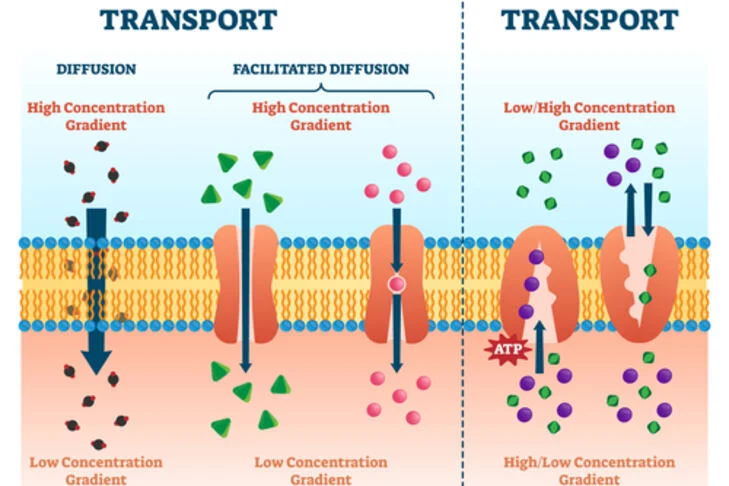Introduction
Cell is the basic unit of life. Cell performs various functions in the body. The cell transports ions, molecules and nutrients across the cell membrane via various mechanisms. Based on the energy requirement cell transport cane be classified as active transport and passive transport. This transport across the cell membrane is important for maintaining cellular homeostasis. In this article we will study transport across cell membrane.
Transport across cell membrane
The contents of cell are completely surrounded by its cell membrane or plasma membrane. This plasma membrane acts as a communication mediator between cell and extracellular medium. There are two major methods for moving molecules across a membrane. Depending on energy requirement these methods are classified as passive transport and active transport.
Passive transport
In this mechanism substances can cross plasma membrane and organelle membrane. This movement is downhill the concentration gradient without using energy. Passive transport can occur by diffusion, facilitated diffusion or osmosis.
Diffusion
Diffusion is the movement of chemical substances from an area of high concentration to an area of low concentration. The plasma membrane act as a semi-permeable membrane and can pass selective molecules. Small substances diffused down the concentration gradient crossing membrane by following mechanisms,
- By dissolving in the lipophilic part of membrane. Example, lipid soluble substances like oxygen, carbon dioxide, fatty acids and steroids.
- By passing through hydrophilic channels or pores in the membrane. Example, small water-soluble substance like sodium, potassium and calcium.
Facilitated diffusion
This process is for the substances which can not diffuse through semi-permeable membrane like glucose, amino acids, etc. Plasma membrane contain specialised protein carrier molecules, which attracts and bind the substances in lock and key mechanism. The carrier then changes its shape and deposit the substance across the membrane. The carrier site is specific and can be used by only one substance.
Osmosis
It is the passive movement of water down its concentration gradient towards equilibrium across semi-permeable membrane. The force with which it occurs is called as osmotic pressure. This mechanism is useful for the molecules which can not be passed through membrane by diffusion method. The water molecule dilutes the more concentrated solution and concentrates the dilute solution. When the equilibrium is reached, having same concentration on the both side of membrane, the solution is said to be isotonic.
Active transport
This is the transport of substances up their concentration gradient (uphill) means from lower concentration to higher concentration. This transport requires chemical energy which is provided by ATP. The carrier sites are specific and can be used by only one substance. Hence the rate of transportation of the substance depends on the number of sites available. Active transport is of two types one is sodium-potassium pump and another is bulk transport.
Sodium-potassium pump
This mechanism maintains homeostasis of two electrolytes, sodium and potassium. Potassium is present intracellularly and sodium is present extracellularly. These ions may diffuse down their concentration gradient like potassium outwards and sodium inwards. In this case homeostasis is maintained by pumping out excess sodium across the cell membrane in exchange for potassium. This pump may utilise up to 30% of the ATP required for cellular metabolism.
Bulk transport
The molecules which can not transported by semi-permeable membrane are transported via bulk transport. Such molecules are engulfed by extensions of the cytoplasm which enclose them forming membrane bound vacuole. When the vacuole is small, pinocytosis occurs and when vacuole is large phagocytosis occurs. Then lysosomes adhere to the vacuole membrane and releases certain enzymes which digest the contents.

Summary
Cell transport is the fundamental process which governs the movement of molecules across the cell membrane. It contains diffusion where substances move from areas of higher concentration to lower concentration. In case of osmosis there is a movement of water molecule across the cell membrane. Active transport mechanism requires energy expenditure. It involves pumping the ions or other molecules against their concentration gradient. Facilitated diffusion and bulk transport depends on the carrier proteins for cellular transport.
Understanding these mechanisms is important to regulate the internal environment of cell. It also ensures the proper balance of nutrients and ions with efficient management of waste products.
Frequently asked questions
What are the 2 types of membrane transport?
Membrane transport is mainly classified into two types based on energy requirement. One is passive transport where energy is not required for transportation and another is active transport which requires energy for transportation.
What is concentration gradient?
It is the gradual change in concentration of a substance within the region. It refers to the difference in concentration of solute between two areas.
What is diffusion?
Diffusion is the natural movement of particles or molecules from an area of higher concentration to area of lower concentration.
What is osmosis?
Osmosis is the movement of water molecules across a semi-permeable membrane from an area of lower concentration of solute to higher concentration of solute, by achieving equilibrium across both sides of membrane.
For more regular updates you can visit our social media accounts,
Instagram: Follow us
Facebook: Follow us
WhatsApp: Join us
Telegram: Join us

2 thoughts on “Transport across cell membrane”